

|
Home Updates Hydros Cars Engines Contacts Links Contact On The Wire |
Ron Moulton's to blame.
It was a copy of Ron Moulton's Encyclopaedia, borrowed from the college library in 1968, and to my shame still on my bookshelf, that started what was to become something of a quest. Bearing in mind that the book was already 10 years old by then and much of the information even older, two entries stuck in my mind. The first was the AMRO, and we know where that led and the second the Kinnersley 10cc. Never got on with standing in a circle and flying a plane round and round, but as an engineering student with a background in full sized racing, engines were a different matter.
It did not matter whether it was bikes or boats, there was an inherent desire (from most) to go faster, and given that almost everyone at that stage was using the same basic equipment that required someone to prepare and 'tune' the engines. The tuners ended up being better known than the original maker, often with their names preceding that of the manufacturer, so one chapter in the Moulton book had me hooked, and that was outlining the work of Fred Carter. What I did not appreciate was that he had by then retired from engine work and according to the fellow flyers at Richmond Park, the engines he had been working on were old hat, superseded by Italian, American and of course Austrian motors with the 'tuned pipe' already having come of age. Any further interest I had at that stage being knocked on the head by those I viewed as being far more knowledgeable and experienced than myself.
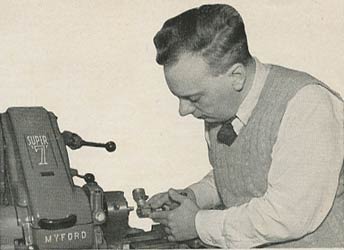 |
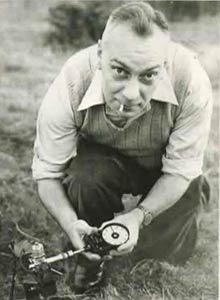 |
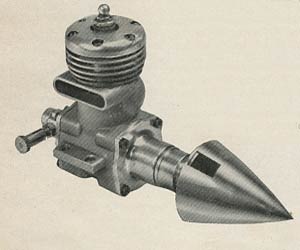 |
| Fred Carter at work on the Dooling 29 | Engine testing | The famous 'Carter Dooling' |
There was little interest in what were considered old engines at the time with second hand Olivers, Rivers etc in the local model shop going for eight quid a go. My Copeman Oliver cost the same and some would claim that was all it was worth, yet many successes were accomplished with motors reworked by him. Fast forward twenty years, having retired from racing full sized hydros, and there I was, drawn back into the world of vintage model engines, although by then they had become collectable and exceedingly expensive. So much so that it was the stories behind them that kindled my interest, rather than the hardware, after all, who would pay that sort of money for a ten quid engine?
Research is significantly easier now with search engines and the digitising of old magazines, but initially, old magazines was all I had, apart from Ron's book, thirty five years out of date, and a few recollections from people who had known Carter. Of course, one person who will be forever linked with the work of Carter is the late Ray Gibbs for his world championship success in 1956, world and national records, along with many other, subsequent, notable achievements including a 2nd place at the 1957 Criterium. What might not be so well known is that Ray moved on from aeroplanes to tethered hydroplanes, so that there were a number of people in that discipline to whom the legend that is Carter was passed on. Indeed, Ray actually raced a hydroplane with a Carter engine in it at one stage.
No real progress, although a couple of engines, reputed to be by Carter turned up at swapmeets, although the consensus of opinion was that they were more recent look a-likes. By 1994 the newest of his engines would have been over 30 years old. Then a coincidence that could never have been engineered, which really kick started the quest in earnest. Until the threat of new housing was raised, a regular jaunt was to the old RAF station at Oakington, near Cambridge where Dick and Babs Roberts organised vintage speed competitions and the current F2A and F21 competitors used to practice. There I met Ray Gibbs for the first time, along with Dave Smith who I knew vaguely for frightening the life out of me with his F21 plane. Dave had been loaned the remnants of the original Carter McCoy 19 by Ray, drawn up a set of planes and recreated Ray's 1956 World Championship winning Nipper plane with the Carter engine. The original motor had long since succumbed to a mixture of 40% nitro and 40% methanol. Watching Ray 'bladder up', start the motor and wind the needle to exactly the correct setting after so many years was an absolute education. Dave's flights were equally impressive, from the initial trial flight to setting a new record in 1996 at 129.58mph, 18mph faster than the existing record, the plane then being retired. Dave, aided and abetted by ace engine guru Taff Bolen also created a true 2.5cc version using an original McCoy crankcase.
|
|
However, the subsequent article in Model Engine World and conversations with Dave and Dick Roberts rekindled my enthusiasm and cemented my regard for Fred Carter. Once these links were made, information and connections started to be forthcoming. Dave had previously discovered he was a cousin of Ray's. Ron Davenport, a notable speed flyer, was still around and with a collection of original Carter motors, which is about where I start. Much of what follows is by courtesy of Dave Smith who has provided numerous articles, photos and recollections of the Carter Engines and of course the late Dick Roberts who inherited Ron's engine collection. Very little had appeared about Fred Carter, prior to his interest in model flying, although he did have a very difficult early life living in Stepney and contracting TB as a child. This confined him to hospital for five years, which left him with a life long disability. He started working as an assistant to a watchmaker after leaving school, possibly in a business run by a relative and almost certainly as he was unable to take on any more strenuous work? Left: Frederick Edward Carter |
Fred started speed flying around 1950 on Wanstead Flats, which was a hot bed of model flying and importantly, adjacent to where Ray Gibbs had his model shop. Fred was also a regular at the hydroplane events at Victoria Park, along with engine designer and builder Basil Miles and George Stone, who had been eminently successful with Doolings in his hydroplanes. The first speed motor Fred modified was a Nordec, which in his 'Little Rocket' plane was markedly quicker than most other 10cc motors and consistently, way over 100mph. As a watchmaker, and like those working with full sized engines, he began to realise that careful work and preparation of a standard engine would increase its performance significantly. As an aside, one wonders if he and fellow speed flyer John Wood of Nordec ever swapped thoughts on improving the engine? Remarkably, Fred's original Nordec survived in the hands of Ron Davenport and later Dick Roberts who installed it in a replica 'Little Rocket'.
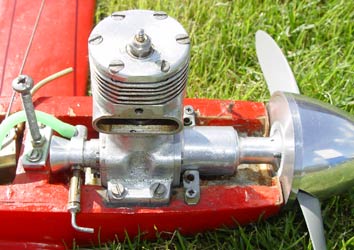 |
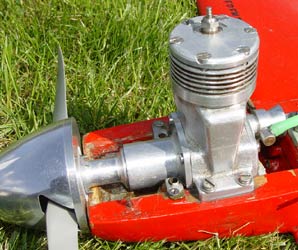 |
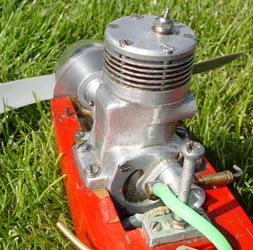 |
| Fred's original Nordec, used by Ron Davenport, restored and flown by Dick Roberts | ||
From 1950 onwards, there are
regular mentions in the aeromodelling magazines of competitors in speed and Team Race
events using engines described variously as 'Carter prepared', 'Carter
re-worked', or 'Carter Specials'. One of the very early converts was Ron
Checksfield, who later worked alongside Fred, before becoming a noted engine designer
in his own right. Photos and articles show Ron using a Carter prepared ETA 29
during the 1951 season.
|
Over a period of around nine years, Fred prepared untold numbers of engines for 2.5cc, later to become F2A, the 5cc, and 10cc Speed classes and team racing. His first really successful 2.5cc speed motors were based on McCoy 19 crankcases. Johnny Hall later confirmed that Fred and Ron Checksfield had built about nineteen of these. It was almost certainly one of these that Pete Wright used in the 1956 World Championships, although overshadowed by Ray Gibbs' success. Pete was something of a legend in speed flying circles having competed from the first ever world championship when diesels were the motor of choice, EDs for Pete and Eifflander Specials for other members of the team before swapping to Webras, Carter engines and SuperTigres prepared by George Copeman.
Ray Gibbs appeared in 1955 with the first mention of a Carter engine in
International competition, although finishing way down the order. |
|
As well as the McCoy 19s, McCoy 61s and SuperTigres also received Fred's attention for the speed categories. However, the article describing his work published in 1958 is a detailed description of how he prepared a Dooling 29, which included all the relevant timings, port dimensions etc. revealing that it produced 0.595bhp at 18,000rpm.
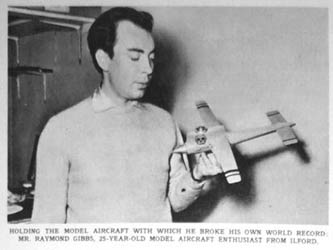 |
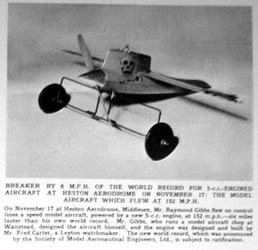 |
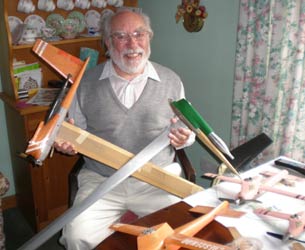 |
| Ray With his 5cc record breaker | 1957 152mph | Ray in later life with planes old and new |
Fred also worked his magic on Dooling 61s, and it was one of these 'Carter Doolings' that Ron Davenport used to finish second in the World Championships in 1953. All the motors were extensively reworked so that there was often nothing left of the original apart from the crankcase and a few other odd bits. More recognisable though are the McCoy 29s used for team racing as Fred reckoned that the crankcases were stronger, so he usually retained the original front housings.
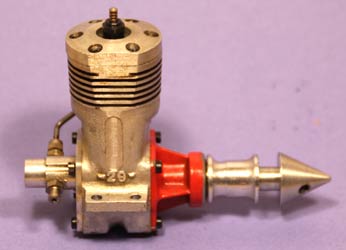 |
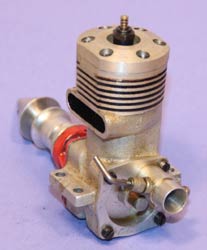 |
 |
| Carter McCoy 29 for team racing retaining the McCoy front end but with an entirely new back plate and venturi | ||
Engine design and technology was moving on rapidly in the late 1950s though, driven by the state sponsored Eastern Bloc companies of Hungary and Czechoslovakia with Moki and MVVS, the Americans with Bill Wisniewski to the fore using the prototype K&Bs and Italians with Jaures Garofali and SuperTigre. Schnuerle porting, boost ports, flat topped pistons and bowl shaped combustion chambers, plus the ability to produce development motors and test resulted in rapid engine development. This was an option that was not existent in the UK as there was no support either from manufacturers or the national authority.
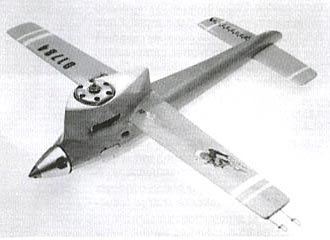 |
 |
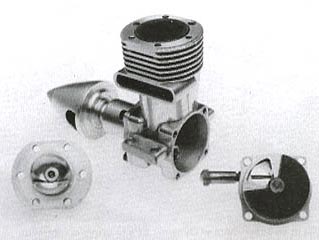 |
| The Gibbs/Carter 'Nipper' McCoy 19 linered down to 2.5cc, fins shaved but not removed | ||
In order to provide a group of British speed flyers with an engine that could compete with these specially built motors, around 1958/59 Fred, along with Ron Checksfield, developed an entirely new motor to accommodate the new trends. This was the first motor Fred built entirely from scratch using a bespoke, sand cast, crankcase, rather than utilising an existing commercial one, which would in all probability have proved impossible to obtain, especially as the new porting systems had been copyrighted. The new engine was still similar in layout to the earlier McCoy but now called a CCS understood to stand for Carter Checksfield Special, although it might well be 'Carter Competition Special' as there is no mention of Checksfield in Peter Chinn's report of the development of the engine? The first appearance of this new motor on the international scene was at the Criterium in Belgium where Johnny Hall had it in an unusual delta design with removable, aluminium wings. As well as Johnny Hall, a number of these motors were supplied by Fred in the early 1960s to British speed flyers that included Pete Drewell, Pete Wright and Norman Butcher. Another, high profile, member of the British team at the time was none other than George Copeman, although, as he confirmed recently, he was using SuperTigre motors supplied directly by Garofali.
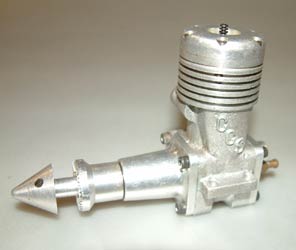 |
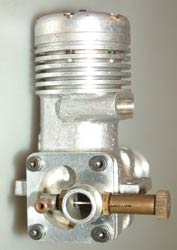 |
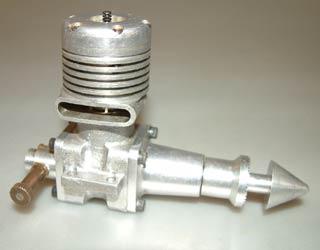 |
| Carter CCS. Was the rear end designed like this, NV position at right angles to normal. TR Mod? | ||
The new motor was developed over a period of two years, the second version having entirely new internals. This was reckoned to be superior to any other 2.5cc motor available in the UK at the time, producing some 20+% more power and revving to 22,000rpm. Pete Drewell used one of these second generation motors to great effect in the British competitions setting new records in the process, with both doped and straight fuel. They were still struggling on the International scene though where the results charts were completely dominated by the Moki, MVVS and SuperTigre motors. Drewell and Norman Butcher represented the UK in World and European Championships in 62 and 63, but the best result they could manage was a 14th for Pete in 62 and 13th for Norman in 63. This was at the expense of several planes and motors wrecked along the way, Pete trashing both his entries in 63 so not recording a speed at all.
Importantly, Fred was at pains to point out that these motors were not for sale and that he could not enter into any correspondence concerning them. It would be another thirty years though before a British flyer with a British engine would achieve international success. As an aside, at the 1961 Criterium Norman Butcher finished in 19th place with his CCS, one place ahead of a certain Paul Bugl, both behind George Copeman.
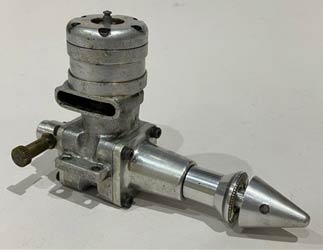 |
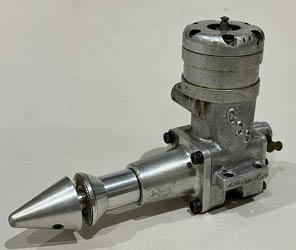 |
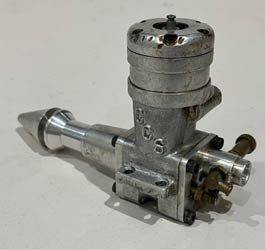 |
| Carter CCS believed to have been used by Johnny Hall, fins removed, NV in central position | ||
The CCS featured in one of Peter Chinn's 'Engine News' reviews where he described the engine in detail. The engine described and tested was the one Pete Wright used to finish 6th at the 1961 Criterium in Belgium, although accident damage had required a rebuild using parts from three engines. The Wright motor, like one of Norman Butcher's retained full finning.
Fred did plan to produce another, up rated, version of his 2.5cc engine with a strengthened crankcase, enlarged transfer and other improvements. The crankcases carried just the CS initials for 'Carter Special', yet this venture never got beyond having the castings produced. One can only assume that trying to compete with the state and commercially sponsored concerns made him realise that he had probably achieved all he could and that there was little point in continuing further? The successful introduction of the tuned pipe to model engines in 1966 changed speed flying, tethered car and hydro racing for ever, relegating the side exhaust engines, firmly, to the collectors shelf.
|
One such engine doing the rounds of collectors is reputed to be have been used by Pete Drewell although there is a bit of a mystery attached to this motor. In an article Drewell wrote in 1963, he confirms that he was using a CCS, in fact several, as reports reveal, yet it is somewhat different to any other of the CCS motors that have come to light. Right: Drewell motor with offset venturi |
|
|
The transfer is more rounded and as the case, still in 'as cast state', bears no evidence of having the CCS initials embossed as all the other motors have, which begs the question as to whether this was a 'one off'? Having now had a chance to see the motor, the casting seems a very different material and finish to the confirmed CCS motors. This motor has no fins, but again, the reports show that both finned and un-finned versions were used in the Championships.
|
|
Most of Fred's motors were either reworked commercial engines or his own CCSs, but less well known is that he did produce a few 'one offs'. Intriguingly, there was a 29 sized motor built for Ron Lucas who had previously used a Carter modified McCoy. Contemporary reports refer to the motor as being a 'scratch built, one off, special'. Whether it had a cast crankcase along the lines of the Drewell 2.5cc. or built from bar stock cannot now be confirmed. Unusually, this motor had the needle valve vertical so that it came through the top of the model. This does raise the possibility that Fred had planned to produce both 2.5 and 5cc versions of the same motor? Ron also used a 2.5cc CCS for team racing, again with a most unusual venturi and needle valve placement. Ron's CCS that was the subject of a test in Model Aircraft also carries a serial number, the only one seen so far with a number. Left: Ron Lucas Carter 29. Unusual venturi and NV placement also appeared on some 2.5cc CCSs |
A bar stock 61 along the lines of a Dooling was also claimed to be one of Carter's having been passed on from Ron Davenport missing all its fins, if it ever had any that is? Dick Roberts cleverly grafted a set of fins on to the engine before it, along with the Nordec, was offered for sale at Gildings. New information indicates that this was probably not one of Fred's engines, but could be another important British designer and builder? Research continues.
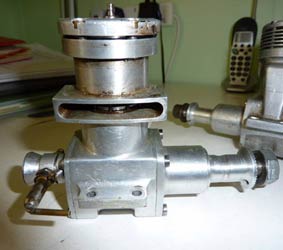 |
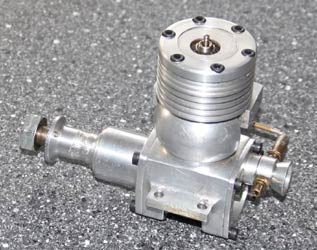 |
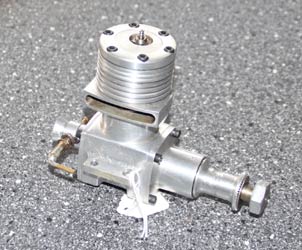 |
The varying position of the venturi on Carter's motors is something of a mystery as there are examples with the venturi almost dead centre at the top of the backplate, slightly offset, well to the right with scallops for the screws and midway down the right hand side with the needle valve at right angles to normal and the Lucas engine with the vertical NV.
After fifteen or so years as a highly respected and effective engine builder, Fred went back to his stock in trade as a watchmaker while the iconic status of his engines slowly grew. Of Fred, little more was heard until he became something of a cause celebre in the mid 1990s, but not connected in any way to models or engines. In 1993 the proposed A12 extension to the M11 required over 200 houses to be demolished and 500+ people relocated, including the half of Fillebrook Road in Leytonstone where Fred lived. He did not go quietly however and refused to move until his was the last house standing along that part of the road, but eventually he had no option but to move, ending up in Scott's Road, Leytonstone. The protests and public outcry surrounding the sit-in and occupation of 135 just along the road made TV and national newspapers, with questions even being asked in parliament.
By the time I returned to the model arena, any engine with the name 'Carter' attached to it was changing hands for alarming amounts of money, but thirty years on, proving the provenance or originality of any such motor was something of a problem. Such a case was the motor that appeared at a Watford swapmeet many years ago. Unfortunately, as it has transpired, what we were told about the engine and what happened at Watford was a third hand, apocryphal story and as far from the truth as it is possible to get. Thanks to the then owner and photos that have recently turned up we can now confirm the identity and origins of this motor. The original linered down 19 that Ray Gibbs won the championship and set records with had been wrecked in Czechoslovakia in 1957 but there was still a direct connection with this engine as Ray confirmed to the owner. Following the crankcase on the original giving up the ghost, Fred Carter put the remaining parts into a new crankcase. It was apparently quite an emotional experience for Ray seeing the engine some fifty years on, at which point the owner put it away. Others may have seen it, but were not privy to the conversation. It was eventually sold a while later but it had an uncanny knack of changing hands at regular intervals as I followed its progress around the UK. Finally, I tracked it down to its third owner. He had paid a lot for it, but because of the conflicting stories he was told was no longer sure of its provenance. So, as far as I know, it still resides there, but if he reads this, then its originality is confirmed from the very best source.
Update Oct 2024: By another of those strange quirks of fate that keeps us going, original photos of this motor arrived in a very large box of assorted material (above). Most obviously, the motor is built with the exhaust on the right, unlike all the other Carter motors based on McCoys. If it is a McCoy crankcase then the logo has been machined off, as has the 'bump'.
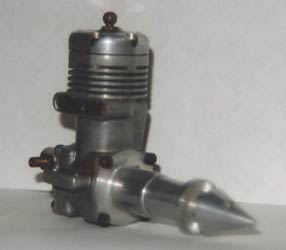 |
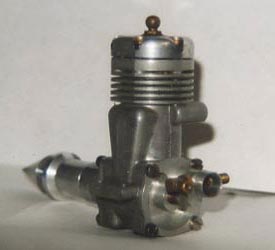 |
 |
| The motor
described above
as seen at the late and lamented Watford swapmeet. |
Another engine claimed to be the 'Nipper McCoy' but probably one of Pete Drewell's CCSs? | |
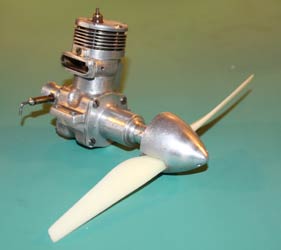 |
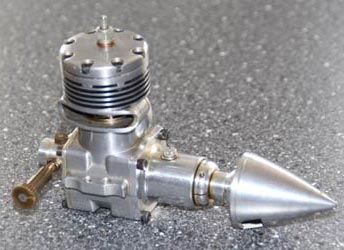 |
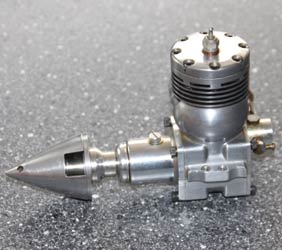 |
| Fred's first speed motor | Carter Dooling 61 that has received serious 'attention' to the mounting lugs | |
|
|
As was common at the time, many of the motors used for speed were shorn of all fins and exhausts trimmed, whereas the TR versions kept the finning intact apart from being flattened on the sides. So, taking a lathe to the fins creates a passable copy of a speed motor, but there is so much on a Carter engine unique to him that close inspection will usually reveal a dubious origin. Fred lived to the grand age of 93, passing away in September 2014 and leaving a very significant amount of money to a Children's charity in recognition of his own, sickly childhood. There must still be a number of people around who knew him and may have even had contact with him in his later years, but all that is left now is the legend and a quest to identify and record as many of his motors as possible, hopefully, with provenance and history. Left: Yet another claiming to be a McCoy 'Nipper' that is actually a CCS |
|
A while ago, Dave Smith had two original CS castings passed on to him, one of which he has built up into a complete motor. Thanks to a number of very helpful enthusiasts acknowledged below, a selection of motors than can be positively attributed to Fred have been photographed. His original Nordec. A heavily modified Dooling 61 and a Carter McCoy 29 TR. Ray Gibbs' Carter Dooling 29. Two fin-less CCS 2.5cc Speed motors and one CCS with fins possibly a TR version. The two speed motors are reputed to be Pete Drewell's who broke several British records and Johnny Hall's, who also broke the 5cc record using a Carter motor. Right: CS and CCS versions showing clear differences in the crankcase castings |
|
|
|
A number of raw CCS castings have also emerged, although the origins of
these are unknown, the latest two being at the BMFA auction in
January 2024.
This appreciation of Fred Carter would not have been possible without the unstinting help, encouragement and kindness of Dave Smith with his willingness to share material and photos. Stuart Robinson, Katie Higgins, John Goodall, Jan Huning and of course, the late Dick Roberts all of whom provided valuable input with examples of motors to photograph. Ray Gibbs' world record at Heston was widely reported in newspapers of the time and even the Illustrated London News, as well as the modelling press where there are many references to Ray, Fred's engines and the collaboration between them. |
I have to add a word of caution though. As I have discovered, there is a wealth of incorrect information and speculation in recent articles and on various forums regarding the identity of Carter motors and even the derivation of the CCS initials, but the primary sources are seemingly as accurate as they can ever be. Photos and further information of Carter engines would be most welcome and very much appreciated. Ron Lucas' CCS and what is claimed to be Ray Gibbs' original Carter Dooling are known to be in existence, so there must be more?
To complete the 50+ year quest it is only appropriate to finish with two sets of photos. The first an original 'Carter Dooling' as featured in the Ron Moulton Book with an unbroken seventy year provenance. The second is as close to the 'Nipper McCoy' as it is possible to get, a 2.5cc replica built by Taffy Bolen and Dave Smith from original parts (unless there is one of the other 18 out there somewhere?).
 |
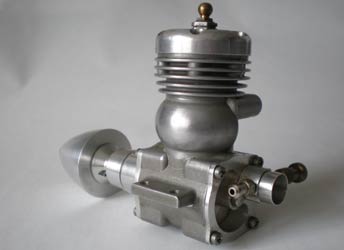 |
|
The late Ray Gibbs' Carter Dooling 29 Exhaust untrimmed as in the original article |
|
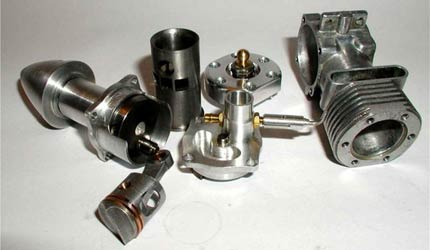 |
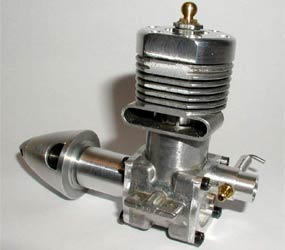 |
| Replica 2.5cc 'Nipper' motor with an original McCoy 19 crankcase built by Taffy Bolen and Dave Smith | |
Update 1 April 2024:
|
In his Aeromodeller article relating how the Taylor glowplug business came into being, Chas Taylor talks about his success in the 1960 World Championship with Gordon Yeldham using a diesel motor, noted in the reports as a 'special'. He then goes on to describe in some detail his B team race activities with Len Steward and their 'beloved Carter/Checksfield McCoy 29'. Chas explained how they manage to increase their speed by over 7mph and add 20 laps on every tank of fuel. This was just an item of interest, but intriguing at the same time as it indicated that Fred was working with Ron on these engines as well as the 2.5s. Nothing further was known about this motors until we received the following from established CL flyer John Dixon. 'I also own a Carter McCoy 29, previously owned by Gordon Yeldham, used by him of course mainly for 'B' team racing with Chas Taylor. I flew it is about 1969 in a 'Razzamachas' in the final of a Rat Race down on the south coast, pitted by Gordon and Len Steward, resulting in a famous win of a 29 over two K&B 40 RVs. I bought the engine a few years ago.' |
|
'It has quite some history that is known. All this can be confirmed independently by Irvin Ella who was at the 1969 (?) Rat Race when it beat the K&B 40RVs. He saw the race and heard the discussion about the engine between Gordon Yeldham, Len Steward, myself and others. Gordon was absolutely delighted, the 40s did not pass us even once.'
|
|
'This is their good sand-cast case McCoy which Yeldham/Steward/Taylor used for many B Team Racing successes, including one win at the Nationals. At an early date there had been a crankcase problem, and Gordon rebuilt the engine into the sand-cast case, which had previously been machined to reduce its width, hence the head protrudes on that side (This looks bad, but this is as it was when used for many years).' 'The PAW needle valve was used because it had the desired diameter. The engine was certainly very good. It only came into my possession relatively recently, but it is exactly as I recall it from 1969, which was agreed by Irvin E. after close inspection. It is shown exactly as in 1969, although I bought it with a Speed type spinner on it.' From the photos, it can be seen that, unlike the other Carter McCoy, which has an extended prop driver. The Y/S/T version has a longer front housing and short prop driver, presumably to reduce the overhang and give a stiffer crank? Yet another variation on venturi location, which has been re-drilled to have the NV horizontal, rather than vertical as it would have been in the TR plane. |
Thanks to John for the photos and text
|
Update 2 April 2024: Having mentioned Johnny Hall in connection with his CCS motor and the 5cc record he set with a Carter Dooling Special we were totally gobsmacked when contacted by the owner of the record breaking plane. If that was not not amazing enough, he was also in possession of the Carter Dooling motor that set the record in 1964 and the certificate issued by the SMAE to record it. Better still, the owner very kindly offered to loan it all to us to photograph and include it as a further update. Certificate records a speed of 153.3mph on 21st June 1964 |
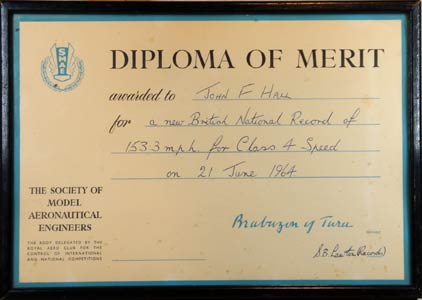 |
The plane is carved from beech with an entirely asymmetric fuselage. The inner side is a curved surface whilst the outer is flat. The speed cowl is also set at a considerable angle with the contrasting, brushed aluminium panels. Tail appears to be balsa. The 'Honeyglo' name probably emanates from the beautiful colour of the wood?
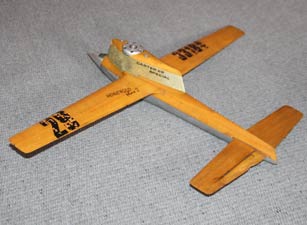 |
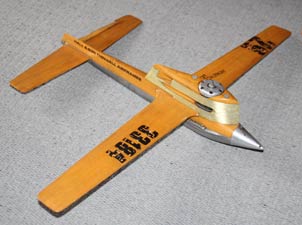 |
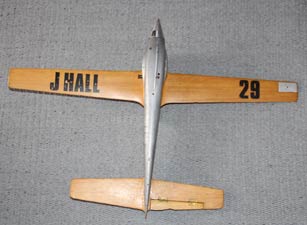 |
| 'Carter 29 Special' Lettering on Cowl | Hall and Son Thinwall Airframes | J. Hall 'Honey Glo Phase 2' |
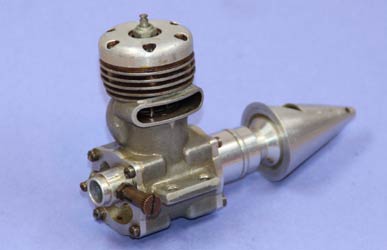 |
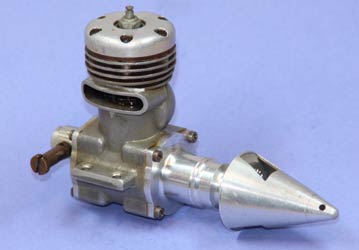 |
|
The Carter Dooling 29. 153.3mph |
|
Ray Gibbs had previously set a world record of 152mph
at Heston Aerodrome in November 1957, also with a Carter Dooling and
here is a unique pair of photos of Ray and Johnny's Carter Doolings.
Both motors have the Dooling name polished off. Another of Ray's motors
is still out there if the Barton forum is to be believed?
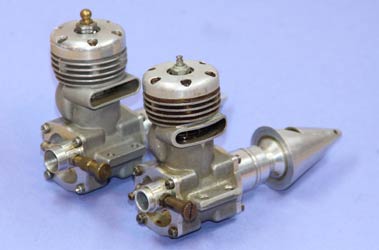 |
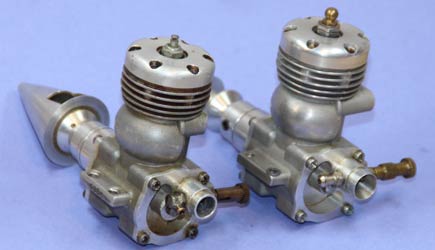 |
| Ray's motor still has the untrimmed exhaust, both still have intact fins | |
We are indebted to the owner of the plane for allowing us to photograph it and include it in the article, thanks.
Update 3 April 2024:
Following a chance
conversation at Buckminster, we have received photos of another two
motors with a connection to Fred Carter. The first is a superbly
engineered replica of the 'Nipper' McCoy and the second, another,
original Carter Checksfield Special, almost certainly from the 62/63
batch, given the extreme positioning of the venturi that matches that on
the Drewell motor. An interesting, historical anomaly to Carter buffs
like ourselves is that Ray Gibbs' original motor was built into a 'bump
lug' McCoy 19 case, but as photos show, the 'bump' was removed. Makes a
dilemma for the builders of the replicas, leave the 'bump' on, or
machine it off?
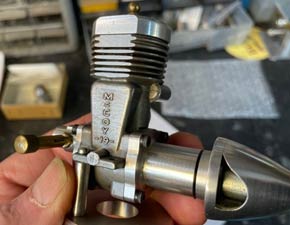 |
 |
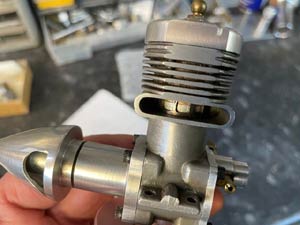 |
| Superbly engineered replica of the Gibbs McCoy by Alan Knight from drawings by Dave Smith made for his own version. | ||
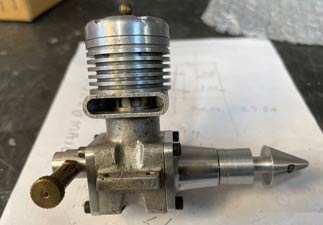 |
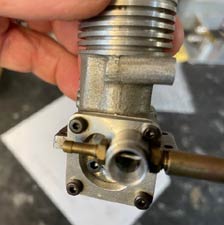 |
 |
| Probably a speed motor from 62/63, given the positioning and size of the venturi. Not all speed motors had the fins removed | ||
Update November 2024: Two more motors come to light.
In Ron Moulton's original article, he pointed out that Fred used a variety of donor motors to build his 'specials' including SuperTigre. This is the first such engine to come to light, and with a remarkable provenance. Further research showed it to be well documented. A magazine article records Ron Irvine using this 'Ray Gibbs Carter Special', based on a SuperTigre, in the Criterium in 1959, but goes on to remark that it was originally built in 1956. The 'SuperTigre' and 'Made in Italy' lettering has been carefully removed, but the S on the bypass side and and 56 on the exhaust side confirm the origins of the motor as a 1956 SuperTigre G20S. It is Carter through and through and like many of his motors, retains the fins on the cylinder. Subsequent information reveals that this was one of two engines built by Fred for Ray Gibbs, but giving a date of 1957. Where is the other one? Pre-auction bidding was brisk as might be expected with its history, especially with the additional information.
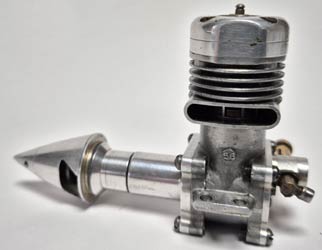 |
 |
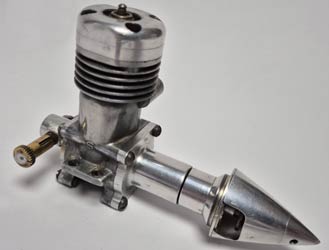 |
|
Ray Gibbs' 'Carter Special' from 1956/57 used by Ron Irvine |
||
The second engine was a bit more of a mystery as it was listed as a 'Checksfield CS Special Carter copy'. Its origins are evident as it is based on a CCS casting, which agrees with the stated date of 1959, but it is not a CS. The middle C was apparently removed from the pattern before the casting was made, which would imply that it was an original from Fred, but probably following the break up of the collaboration with Ron Checksfield who started to build his own motors for Ray Gibbs around then. Again there is a connection with Ron Irvine, who it transpires was actually the builder of the motor, using original parts supplied by Fred. The additional information concerning these two motors was published after the sale catalogue was published but before the auction, adding to the provenance of both and probably accounting for the enthusiastic pre-sale bidding that had them way beyond top estimate within days. Bidding opened at £400 for the G20 based motor and carried on without pause before it finished at £540 hammer price. Each of the last three engines sold with Carter provenance have made £600+ confirming the desirability of any motor with a connection to Fred.
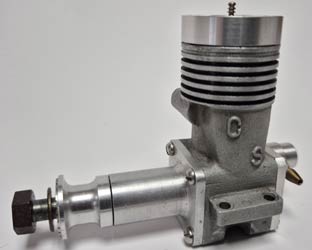 |
 |
|
Carter CCS based motor masquerading as a CS but built by Ron Irvine |
|
Ironically the second motor did not attract the same initial attention and even when the additional information was made available did not go mad, making less than half of what the 'Special' above realised.
©copyrightOTW2024